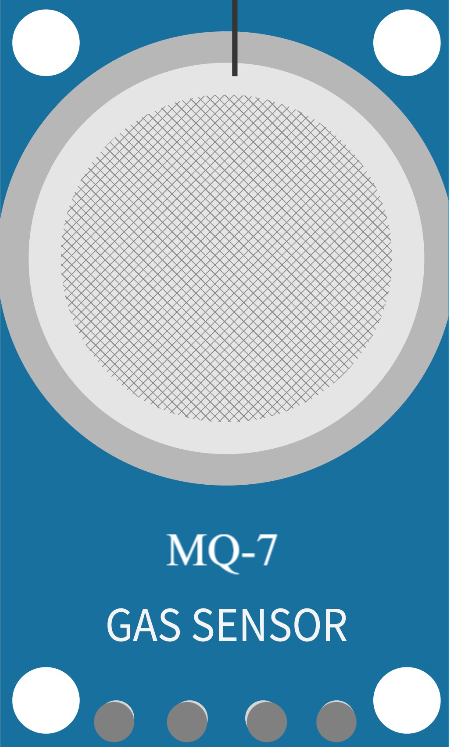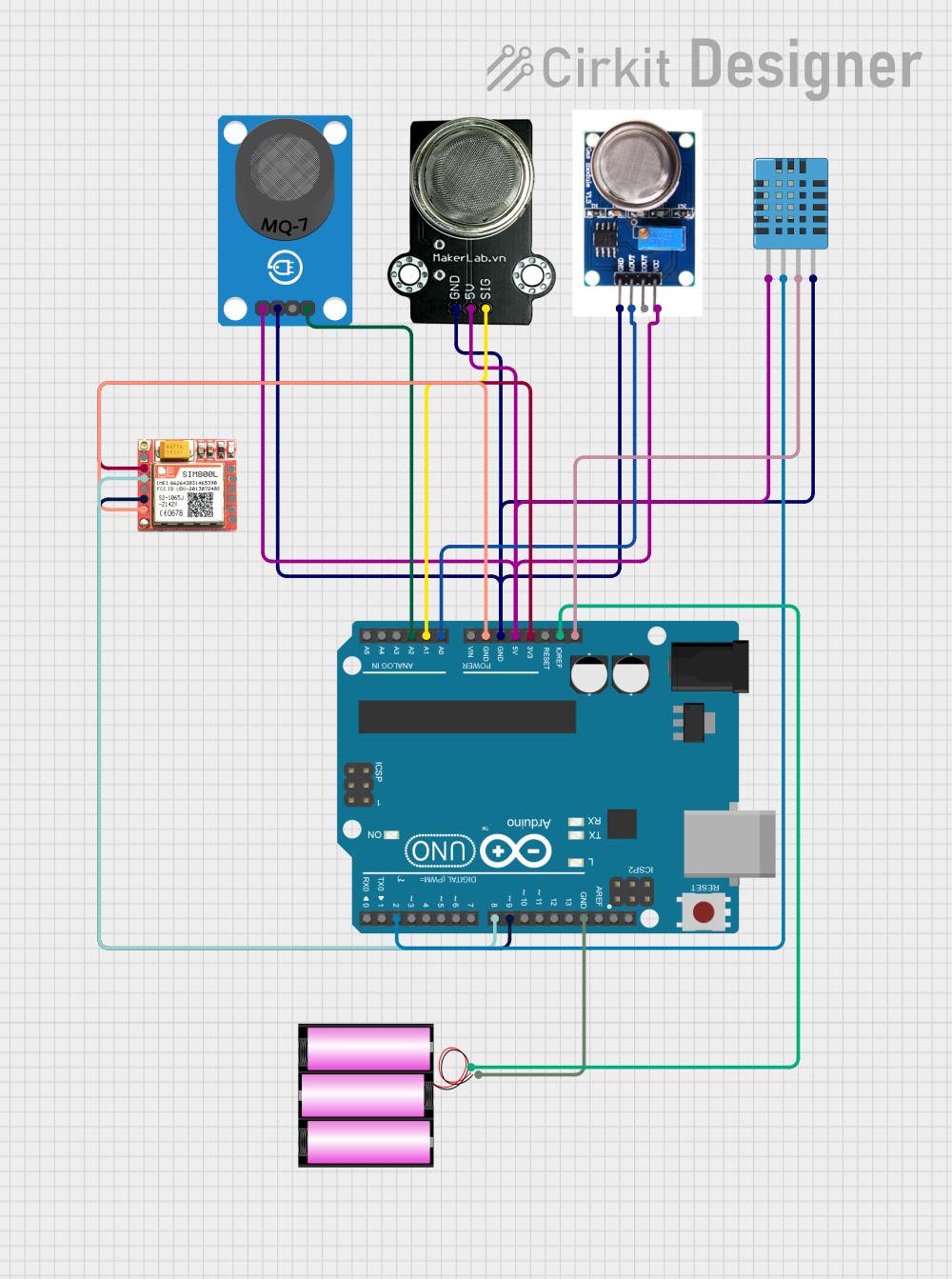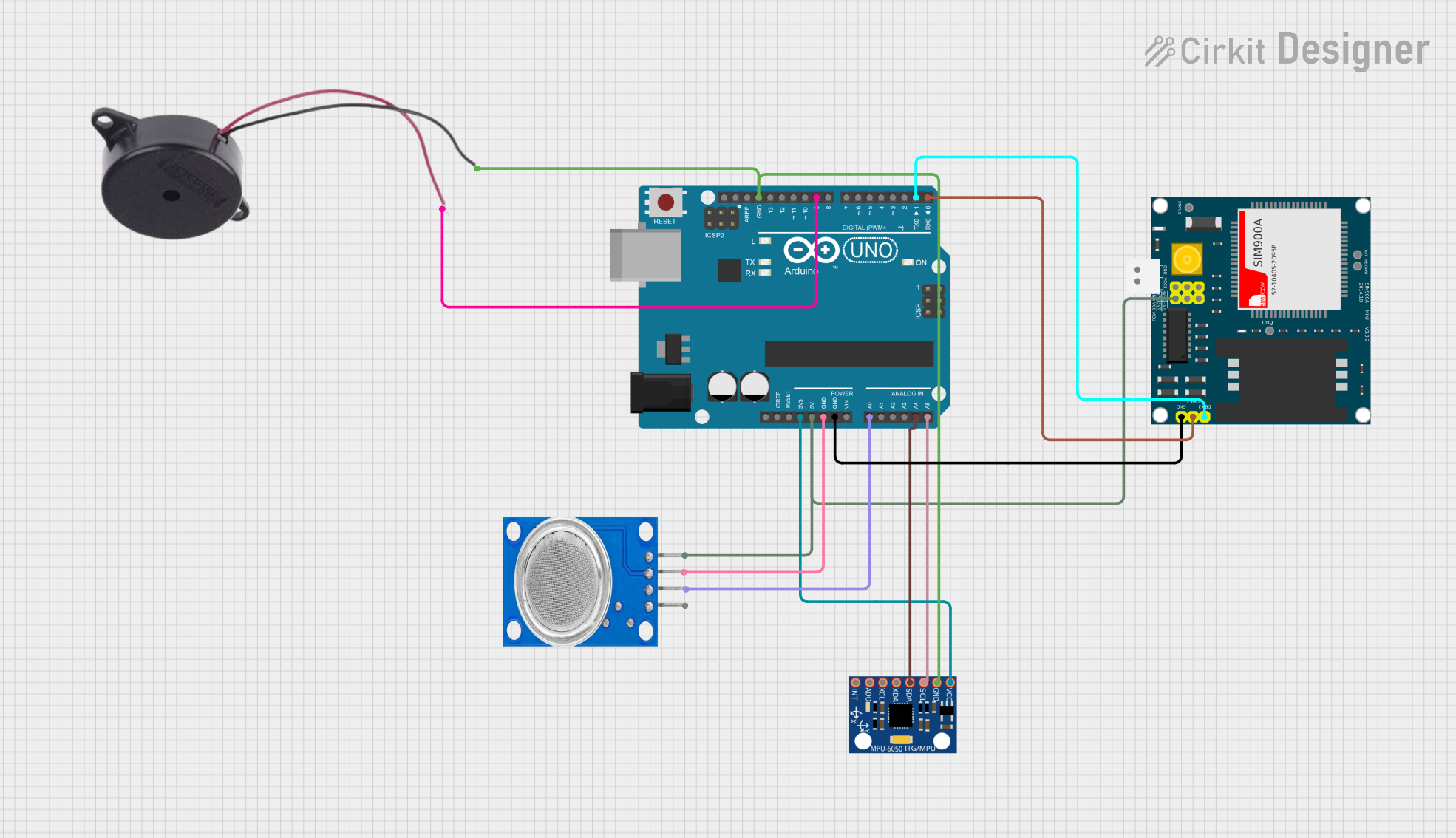
How to Use MQ7: Examples, Pinouts, and Specs

 Design with MQ7 in Cirkit Designer
Design with MQ7 in Cirkit DesignerIntroduction
The MQ7 is a gas sensor designed to detect carbon monoxide (CO) concentrations in the air. It operates on the principle of resistive change, where the sensor's resistance varies in the presence of CO gas. This change is converted into an analog output signal, which can be processed to determine the concentration of CO in the environment. The MQ7 is widely used in safety systems, air quality monitoring, and industrial applications.
Explore Projects Built with MQ7

 Open Project in Cirkit Designer
Open Project in Cirkit Designer
 Open Project in Cirkit Designer
Open Project in Cirkit Designer
 Open Project in Cirkit Designer
Open Project in Cirkit Designer
 Open Project in Cirkit Designer
Open Project in Cirkit DesignerExplore Projects Built with MQ7

 Open Project in Cirkit Designer
Open Project in Cirkit Designer
 Open Project in Cirkit Designer
Open Project in Cirkit Designer
 Open Project in Cirkit Designer
Open Project in Cirkit Designer
 Open Project in Cirkit Designer
Open Project in Cirkit DesignerCommon Applications and Use Cases
- Carbon monoxide detection in homes and workplaces
- Air quality monitoring systems
- Industrial safety equipment
- Automotive exhaust monitoring
- Portable gas detection devices
Technical Specifications
The MQ7 sensor is a versatile and reliable component. Below are its key technical details:
| Parameter | Value |
|---|---|
| Operating Voltage | 5V DC |
| Load Resistance (RL) | Adjustable (typically 10 kΩ) |
| Heating Voltage (VH) | 5V (high) / 1.4V (low) |
| Heating Time | 60 seconds (high) / 90 seconds (low) |
| Detectable Gas | Carbon Monoxide (CO) |
| Detection Range | 20 ppm to 2000 ppm |
| Sensitivity | 2% to 4% change in resistance per ppm |
| Preheat Time | ≥24 hours |
| Analog Output | 0V to 5V |
| Operating Temperature | -20°C to 50°C |
| Humidity Range | 5% to 95% RH (non-condensing) |
| Dimensions | 32mm x 20mm x 22mm |
Pin Configuration and Descriptions
The MQ7 sensor typically comes with four pins or terminals. Below is the pinout description:
| Pin | Name | Description |
|---|---|---|
| 1 | VCC | Power supply pin (5V DC) |
| 2 | GND | Ground connection |
| 3 | AOUT | Analog output pin (provides voltage proportional to CO concentration) |
| 4 | DOUT | Digital output pin (high/low signal based on threshold) |
Usage Instructions
How to Use the MQ7 in a Circuit
- Power Supply: Connect the VCC pin to a 5V DC power source and the GND pin to ground.
- Analog Output: Connect the AOUT pin to an analog input pin of a microcontroller (e.g., Arduino) to read the sensor's output voltage.
- Digital Output: Optionally, connect the DOUT pin to a digital input pin of a microcontroller. This pin provides a high/low signal based on a preset threshold.
- Load Resistor: Use a load resistor (RL) between the AOUT pin and ground. The value of RL can be adjusted to calibrate the sensor's sensitivity.
- Preheating: Allow the sensor to preheat for at least 24 hours before taking accurate measurements.
Important Considerations and Best Practices
- Heating Cycle: The MQ7 requires a heating cycle for accurate readings. Alternate between 5V (60 seconds) and 1.4V (90 seconds) on the heater pin.
- Calibration: Calibrate the sensor in a known CO concentration environment to improve accuracy.
- Ventilation: Ensure proper ventilation around the sensor to avoid saturation or false readings.
- Avoid Contaminants: Keep the sensor away from water, oil, and other contaminants that may damage it.
- Arduino Connection: When using with an Arduino, connect the AOUT pin to an analog input (e.g., A0) and read the voltage to determine CO levels.
Example Arduino Code
Below is an example of how to use the MQ7 sensor with an Arduino UNO:
// MQ7 Carbon Monoxide Sensor Example
// Connect AOUT to Arduino A0, VCC to 5V, and GND to GND
const int mq7Pin = A0; // Analog pin connected to MQ7 AOUT
float sensorValue; // Variable to store sensor reading
void setup() {
Serial.begin(9600); // Initialize serial communication
pinMode(mq7Pin, INPUT); // Set the MQ7 pin as input
}
void loop() {
// Read the analog value from the MQ7 sensor
sensorValue = analogRead(mq7Pin);
// Convert the analog value to voltage (0-5V range)
float voltage = sensorValue * (5.0 / 1023.0);
// Print the voltage to the Serial Monitor
Serial.print("Sensor Voltage: ");
Serial.print(voltage);
Serial.println(" V");
// Add a delay for stability
delay(1000);
}
Troubleshooting and FAQs
Common Issues and Solutions
No Output or Incorrect Readings:
- Ensure the sensor is properly powered (5V to VCC and GND connected).
- Verify the load resistor (RL) is correctly installed and has an appropriate value.
- Allow sufficient preheating time (≥24 hours) for accurate readings.
Fluctuating or Unstable Readings:
- Check for proper ventilation around the sensor.
- Ensure the heating cycle (5V/1.4V) is correctly implemented.
- Avoid placing the sensor in environments with high humidity or contaminants.
Sensor Saturation:
- If the sensor is exposed to high CO concentrations for extended periods, it may saturate. Remove the sensor from the environment and allow it to recover in clean air.
Digital Output Not Triggering:
- Adjust the threshold potentiometer (if available) to set the desired CO concentration level for triggering the DOUT pin.
FAQs
Q1: Can the MQ7 detect gases other than CO?
A1: The MQ7 is specifically designed for CO detection. While it may respond to other gases, its sensitivity and accuracy are optimized for CO.
Q2: How do I calibrate the MQ7 sensor?
A2: Place the sensor in an environment with a known CO concentration and adjust the load resistor (RL) or threshold potentiometer to match the expected output.
Q3: Can I use the MQ7 without the heating cycle?
A3: No, the heating cycle is essential for accurate CO detection. The sensor alternates between high and low heating voltages to maintain proper operation.
Q4: What is the lifespan of the MQ7 sensor?
A4: The MQ7 has a typical lifespan of 2-3 years under normal operating conditions. Regular maintenance and proper usage can extend its life.
Q5: Is the MQ7 suitable for outdoor use?
A5: The MQ7 is not designed for outdoor use due to its sensitivity to humidity and contaminants. Use it in controlled indoor environments for best results.